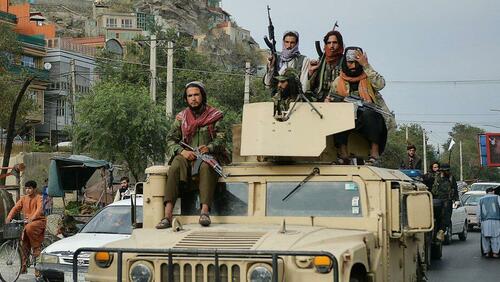Taliban Deploys Heavy Reinforcements To Iran Border After Clashes
Videos circulating social media on Wednesday show Taliban forces heavily reinforcing the Afghan border with Iran, after significant escalation regarding a water dispute between the two countries, which resulted in heavy border clashes between the two sides over the weekend.
The clashes broke out on Saturday between Taliban troops and Iranian border guards, resulting in the death of two Iranian border guards and a Taliban militant, despite unconfirmed reports of further Taliban casualties.
The outbreak of fighting came a week after Iranian President Ebrahim Raisi warned the Taliban to respect Iran’s rights to water from the Helmand River shared between the two countries, under the 1973 Afghan-Iranian Helmand River Treaty. Iran has long accused Afghanistan of restricting the flow of its water to Iran and causing droughts or dry spells.
Each side claimed that the other had initiated the clashes. On May 29, Iran’s Interior Minister Ahmad Vahidi said that calm had prevailed on the border but that Tehran would respond with force if the Taliban resumed provocation.
The Taliban defense minister said on the day that the fighting broke out that the Afghan government views dialogue and negotiation as the best way to resolve issues. Other Afghan officials echoed the defense minister’s words and called for the prevention of escalation.
Other officials and Afghan figures were seen in videos on social media making inflammatory statements. The most notable of these figures is Taliban leader Abdul Hamid Khorosani, who was seen in a video on Twitter May 28 threatening that “if the [religious authorities] allow us, we will seize Tehran.”
“Do not test our strength. You are behind the scenes with the Westerners,” Khorosani added, addressing the Islamic Republic. Reports suggest that Khorosani had been dismissed earlier this month over differences with Taliban leadership.
The Iranian Interior Ministry claimed on Wednesday, following the release of the footage on the Afghan-Iranian border, that those who made statements against Iran were “low-ranking” members of the Taliban who have since been “dismissed” by the organization.
Taliban sends heavy equipment to the border with Iran as tensions escalate over water dispute pic.twitter.com/cGAModswE3
— The Cradle (@TheCradleMedia) May 31, 2023
Iranian media outlets have also claimed that border-crossings between the two countries are now open, despite having been closed following the outbreak of clashes. “Clashes happened based on a mistake made by the Afghan border guards. We have had several incidents like this so far. We advise Afghan authorities to justify the actions of their border guards,” the Iranian Interior Ministry added.
Despite videos showing reinforcements on the border, Iranian media reports suggested that some “elements are trying to provoke the parties involved with rumors and fake news.”
One Iranian report said that there is complete calm on the border. However, conflicting reports continue to emerge, with some suggesting that the reinforcements are ongoing.
The situation at the border with Iran is intensifying as the Taliban actively moves armored vehicles, including tanks.
Iranian border guards have requested additional support and tanks are being dispatched to assist them.
Unfortunately, the situation is unfolding in a… pic.twitter.com/wR8zuxwEkG
— 301 Military (@301military) May 31, 2023
In December 2021, brief clashes broke out on the Afghan-Iranian border between Iran’s border guards and Taliban fighters. In June of the following year, an Iranian border guard was killed by the Taliban. Iran urged the Afghan government at the time to “punish the perpetrators” and take action to prevent a repeat of such occurrences.
Footage from the weekend border clashes…
Clashes break out between Iran and Taliban on the border, casualties on both sides have been reported pic.twitter.com/rHVOWSKJ8n
— The Cradle (@TheCradleMedia) May 27, 2023
Following Washington’s chaotic withdrawal from Afghanistan in 2021, the US army left behind $7.12 billion in military equipment in the country, which immediately fell into the hands of the Taliban.
Tyler Durden
Wed, 05/31/2023 – 20:05
via ZeroHedge News https://ift.tt/W1ENlmR Tyler Durden

